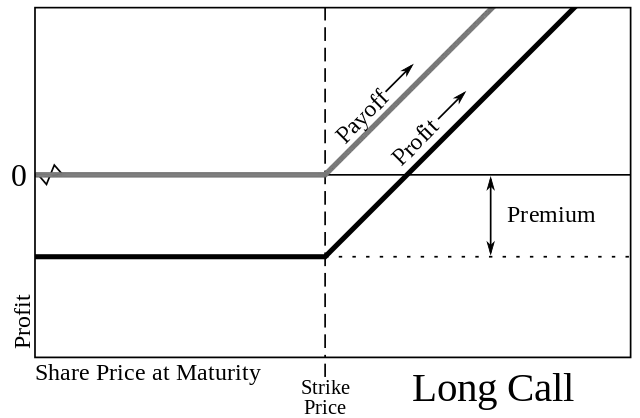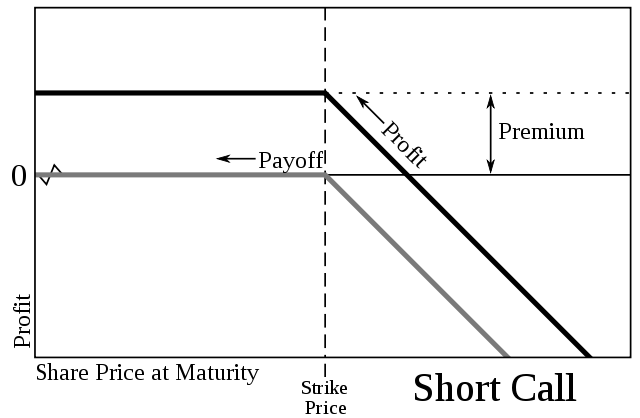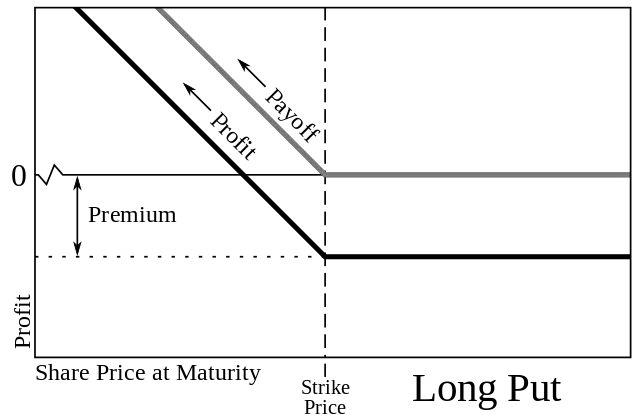Option contracts represent a bet on the directional price movement of an underlying stock in a defined time period. Option contracts represent 100 shares of a stock and are written on time frames of weekly, monthly, and yearly. The price of an option contract is based on the probability of it being in-the-money at expiration. The Black-Scholes price model for options is based on the factors of time remaining before expiration, volatility, and how much it moves in correlation with the underlying stock. Interest rates can also be a small factor in the option price.
An option contract isn’t an investment, it’s a bet on price action. They are deteriorating assets and their value is tied to the movement of the stock they are written on.
What are the 4 types of options?
There are four types of basic options positions you can hold: buying a call option, short selling a call option, buying a put option, and short selling a put option.
A call option gives the buyer of the contract the right but not the obligation to purchase the underlying asset at a set price before expiration. The call buyer has the right to call the asset away from the option seller at the strike price of the option on or before the date of expiration for American options. European style options allow execution only on the day of expiration.
Long call options are bullish bets.

Short call options are bearish bets.

A call option is a contract that is created by an option trader selling to open a financial contract that gives the buyer of the call option the right to buy a stock or commodity at a set price before a specific expiration date. The asset that the option price value is written on is called the underlying.
For stock options, contracts are written for 100 shares of stock. So an option price quote is multiplied by 100 to get the price of a stock option contract.
The call option buyer does not have to hold the contract to expiration and exercise it. During the life of the call option contract the buyer can trade the option on price fluctuations at higher or lower prices as it fluctuates based on the price of the underlying contract.
The call option buyer makes money when the underlying asset goes up in price increasing enough to drive the value of the option higher.
Call options are the opposite of put options, a put option buyer as the right to sell the underlying asset at the strike price before the expiration date.
Call options can be sold as a covered call when the underlying asset that the contract is written on is owned by the seller. The buyer pays the cost of the call option for the right to profits of the underlying stock by expiration.
Call options are not investments they are a bet and a speculation on the magnitude of the price movement of the underlying within a specific time period.
The call option delta is the amount the price should move based on a $1 move in the underlying asset. This is determined by the changing probability of the option expiring in-the-money.
Gamma is the amount that delta should change on a $1 move in the underlying asset price. Delta is the speed at which option prices adjust to the underlying, Gamma as the rate of acceleration of that change.
Theta is the time decay or the amount that the option contract drops in value each day as expiration of the call approaches. Theta decay drops the value for the option buyer and goes in favor of the option seller that is short the call option.
Vega is the amount a call option price should move for each $1 change in implied volatility. Vega tries to price in the risk to the seller of a big price move before expiration.
Call options can be great trading tools for income generation on existing stock positions by selling covered calls repeatedly. Calls can also be bought to create leverage on long positions in stocks in place of equity. Call options can bring in the dynamics of, leverage, time, and the magnitude of price change as new elements for stock traders.
Call options are neither good nor bad they can be a part of any trading strategy if the risk is fully understood.
Long put options are bearish bets.
A put option gives the buyer of the contract the right but not the obligation to sell the underlying asset to the seller of the option at the strike price on the day of expiration. The put buyer has the right to ‘put’ or sell the asset to the option writer for the strike price on or before the date of expiration. European style options allow execution only on the day of expiration.

Short put options are bullish bets.

A put option contract gives the buyer of the contract the right to sell the underlying asset at the strike price of the put on the day of expiration and assignment.
When writing a put option you create a sell to open order with your option broker. This is how you sell put options short as a way to get paid a premium to buy a stock at the lower price you want if your put option strike price is reached before expiration. If your buy price is not reached then you keep the premium you collected to sell the put option contract.
A put option contract seller is paid when they sell to open a put option and receives a premium for agreeing to have stock put on them at a set price by a specific date. The put writer has agreed to buy a stock at the strike price of the put option they sold.
The buyer of the put has the right but not the obligation to exercise the option and “put” the underlying asset on the put option seller by assignment. This would create a long position in the put option sellers account. The buyer of a put option is making a bearish bet on when a stock will close below a certain price.
The put option buyer makes money if the underlying stock closes below the strike price by expiration and adds more in intrinsic value than the option cost in extrinsic value. At anytime in the life of the put option it can go higher in value with a strong move down in the stock and be sold for a profit before expiration.
Put option contracts usually trade in contracts of 100 shares of stock. Also mini-contracts in some option chains have traded in the past that were written on less than 100 shares.
Put options are not financial assets like bonds, stocks, or commodities they are simply trading vehicles. A put option is a bet that a stock will go down to an approximate price in a set time period.
While put options do provide leverage with the ability to control much more stock than if you just bought the shares the level of risk is correlated to your position size. The probability of an option getting to its strike price in your timeframe before the contract expiration should also be a major consideration of the risk of loss.
Similar principles of profitable trading apply to options that apply to other financial markets. The difference is that with long put option contracts you can capture the full downside move of an underlying asset during a trend while the risk of loss is capped to the price you paid for the option contract versus the theoretical unlimited risk of a short position that can theoretically go up to any price.
Put options increase in value as the underlying stock goes lower and gets closer to the option strike price increasing Delta and extrinsic value. If volatility increases the value of Vega the put option price goes higher. If a put option goes in the money then it can increase in intrinsic value.
A put option can drop a little in value each day as time goes by and Theta is priced out unless the underlying stock moves down far enough to offset the time decay with growing extrinsic or intrinsic value.
Traders that are bullish sell put options short. Traders that are bearish buy put options.
Put options are great tools for both leveraging more buying power and at the same time quantifying the risk.
Options can be sold at any time at their current value and don’t have to be held until expiration.
Options are fungible assets and the option contracts are interchangeable and not specific to the original buyer and seller but traded on the open market among different buyers and sellers.
What happens when an option expires?
When an option contract reaches its expiration date it expires worthless if it’s out-of-the money and can be executed as a trade if it’s in-the-money. An in-the-money call option has the underlying stock called from the option seller at expiration and an in-the-money put option has the stock put on the put seller at expiration.
A covered call will have the underlying stock called from the option writer for the strike price at expiration and the cash-secured put seller will have the stock put on them at the strike price at expiration. The buyer of an option that goes in-the-money can sell it before expiration to avoid having delivery of the shares for the call options or selling the shares for the price of the put option strike price.
Is selling options better than buying?
A common misunderstanding among new option traders is that 80% to 90% of all option contracts expire worthless, so a seller of option premium will have a higher win rate than a trader that buys options. This belief misinterprets a statistic published by the Chicago Board Options Exchange (CBOE) that only 10% of option contracts are held until expiration and then exercised.
Just because 10% of option contracts are held and exercised doesn’t automatically mean the other 90% expire worthless. This doesn’t take into account how options are traded profitably between when they are opened and closed. According to the CBOE, between 55% and 60% of options contracts are simply closed out prior to expiration. In other words, a seller who sold-to-open or bought-to-open a contract will, on average, buy-to-close or sell-to-close it 55-60% of the time before expiration, which could be at a profit or a loss.
Very few option sellers are holding the short contract through to expiration, they are closing their position when the risk/reward ratio favors buying it back for a profit or cutting a loss if the move went against them instead of holding the open risk until expiration. So the options that are closed prior to expiration are removed from the expired for a loss statistic. They could have been closed for a loss or a gain before expiration. The data shows that more than 30% of option contracts expire worthless, which is a lot less than the 80% – 90% that is commonly believed.
If only 10% of open options contracts ever end up being exercised, and 55-60% get closed out before expiration, then only 30%-60% of contracts expire worthless. So the expiration rate could be really closer to 45% if the middle of the range is considered which is closer to 50% than 90% and would make sense in a zero sum market. Since buyers and sellers are always equal in a contract market that would mean that directionally their is little edge whether short or long options. Since this considers both puts and calls and all ranges of in-the-money and out-of-the-money options it could show that the options pricing model is accurate most of the time.
It is important to consider that options can be traded back and forth for profits or losses for the entire time before expiration. Expiration only marks one day out of a month for most options. The real question that new option traders have to ask themselves is not how many options expire worthless, but of the 55-60% that actually get closed out before expiration, how many times did the option seller profit and how often did they buy back their short option to close for a loss?
The majority of losing short side option trades would be closed before expiration for a loss to stop the risk exposure of a short contract that is going deeper in-the-money. Option sellers could be closing their short option trades before expiration to cut their losses short. The question about what side of an option trade is the most profitable the short or the long side can’t be answered by how they expired in or out-of-the-money but how options traded over the full life of the contract. Options can fluctuate wildly in price over their life span and the open interest always fluctuates. Long side traders could be selling options for wins long before expiration. I know of almost no long side option trader that holds options until expiration whether it is a winner or loser. Options are so volatile that option traders must take their profits off the table while they are there, not leave their profits exposed to loss until expiration.
Options are a zero sum game; for every long there is a short. For every option profit there is an option loss. Options are fungible and interchangeable so they are traded back and forth as they march toward expiration. Options will change hands many times before expiration and these trades are where option buyers can profit before their time runs outs. Options can be traded profitably from the long side by taking the profits while they are there. Option profits are not just determined at expiration, but are determined as they occur everyday. Option premium sellers can be hurt during trends.
Very few traders hold a put option contract into expiration and have the stock put on them. Also few call option sellers hold through expiration and have their stock called away from them. Options are used for trading and hedging other positions 90% of the time that is where that number really comes from.
The risk and probabilities play out about even over the long run with option sellers collecting a lot of small wins and some big losses and the option buyers having a lot of small losses and some big wins. The winners are not on the long or short side exclusively but with the option traders with an edge, risk management, and discipline. Consider this the next time the expiration statistic is tossed around in favor of selling option premium.
For more information about option trading you can check out my book Options 101 on Amazon or my more in depth eCourse Options 101.